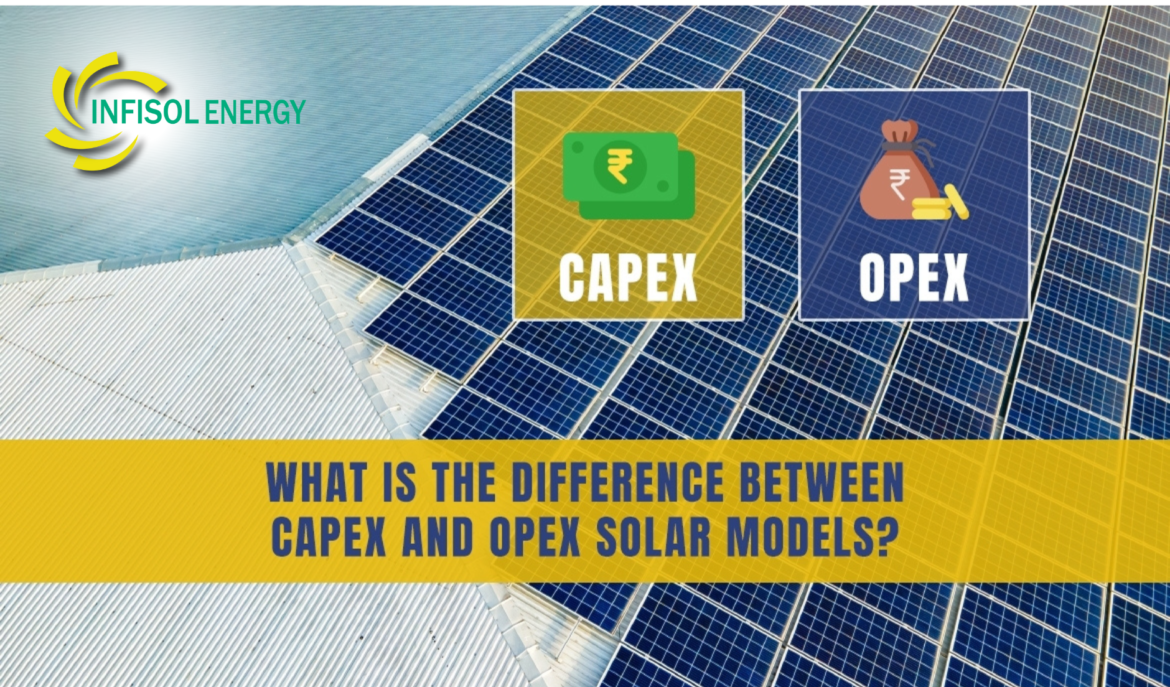Table of Contents
Introduction
In the dynamic realm of renewable energy, the choice between Capital Expenditure (CAPEX) and Operational Expenditure (OPEX) models holds significant weight when financing rooftop solar projects. This article delves into the intricacies of these financing approaches, unveiling their distinctive attributes, benefits, and drawbacks. By scrutinizing pivotal factors and illustrating real-world instances, we aim to equip you with the knowledge needed to make an informed decision tailored to your solar aspirations.
Understanding CAPEX: A Strategic Investment
Capital Expenditure (CAPEX), as the name suggests, involves upfront investment to acquire and install solar assets. This model epitomizes the adage “spend money to make money.” In this framework, organizations or individuals invest substantial resources into the solar project, becoming the owners of the system and reaping its rewards over time.
However, CAPEX demands meticulous financial planning and a robust balance sheet. It necessitates a comprehensive understanding of project costs, system maintenance, and potential risks. Moreover, depreciation of assets is factored in, which can be beneficial from a tax perspective.
Pros of CAPEX:
1. Ownership and Control: Opting for CAPEX confers full ownership and control over the solar infrastructure. This translates into autonomy over system customization, maintenance schedules, and performance optimization.
2. Long-Term Financial Gains: While the initial investment might be substantial, CAPEX tends to yield higher long-term returns. The absence of recurring lease payments means that the financial benefits grow as electricity savings accumulate.
3. Tax Advantages: CAPEX projects often enjoy tax incentives, including depreciation deductions and investment tax credits, which can significantly alleviate the upfront financial burden.
Cons of CAPEX:
1. High Initial Investment: One of the most significant barriers to CAPEX is the substantial upfront cost. This can strain budgets and deter organizations with limited financial capacity.
2. Risk Exposure: Ownership entails assuming all risks associated with system performance, maintenance, and potential technological obsolescence.
3. Resource Allocation: The capital invested in the solar project could have been allocated to other business ventures, potentially impacting liquidity and growth opportunities.
Exploring OPEX: Operational Simplicity
Operational Expenditure (OPEX) is an alternative financing model that offers a more accessible entry point to solar adoption. In this scenario, a third-party developer or financier retains ownership of the solar system, and the host entity pays periodic operational fees or lease payments.
The OPEX model appeals to entities seeking hassle-free renewable energy integration without the initial financial jolt. It’s akin to leasing a vehicle, relishing the benefits without shouldering the responsibility of ownership.
Pros of OPEX:
1. Low Barrier to Entry: OPEX requires minimal upfront investment, rendering solar adoption feasible for entities with budget constraints or those prioritizing immediate cost savings.
2. Outsourced Maintenance: The onus of system maintenance and performance falls on the third-party owner, reducing operational complexities for the host entity.
3. Technological Upgrades: OPEX allows for easier integration of new technologies and system upgrades, keeping the solar infrastructure at the forefront of innovation.
Cons of OPEX:
1. Limited Financial Gains: While OPEX provides immediate cost savings through reduced energy bills, the long-term financial benefits might be lower compared to CAPEX due to recurring payments.
2. Dependency on Third Parties: The host entity relinquishes control over the solar system, relying on the third party for maintenance and performance.
3. Cumbersome Contracts: OPEX arrangements often involve intricate contracts, necessitating thorough legal scrutiny and potential complexities during contract negotiations.
Factors Influencing Your Decision
Several factors warrant consideration when choosing between CAPEX and OPEX financing models for your rooftop solar project:
1. Financial Capacity: Assess your financial capability to make an informed decision based on available capital and budget allocations.
2. Long-Term Goals: Align your financing choice with your long-term objectives, whether they involve substantial financial gains, system ownership, or quick cost savings.
3. Risk Tolerance: Evaluate your appetite for assuming operational and performance risks versus outsourcing them to a third party.
4. Tax Implications: Delve into the tax benefits and implications associated with each model, as they can substantially impact your financial outcomes.
Case Studies: Realizing Success
Real-world case studies underscore the viability of both CAPEX and OPEX models:
1. CAPEX Triumph: Company A invested upfront in a rooftop solar project, capitalizing on tax incentives and enjoying complete ownership. Over the years, their energy savings surpassed initial expenditures, demonstrating the long-term financial prudence of CAPEX.
2. OPEX Efficiency: Hospital B chose an OPEX model, channeling limited funds toward critical patient care. Their consistent operational fees granted them immediate energy cost reductions, enabling sustainable healthcare without compromising resources.
Conclusion
The decision to opt for a CAPEX or OPEX financing model for your rooftop solar project hinges on your financial prowess, risk tolerance, and long-term aspirations. CAPEX empowers ownership and potentially higher returns, while OPEX offers operational simplicity and immediate savings. By evaluating these models through a strategic lens and considering pertinent factors, you can illuminate your path toward a sustainable solar future.
Simplify your solar journey with our free PDF download on OPEX vs. CAPEX. Enhance your understanding and make an informed decision about going solar. Visit to access the PDF and learn more.”

